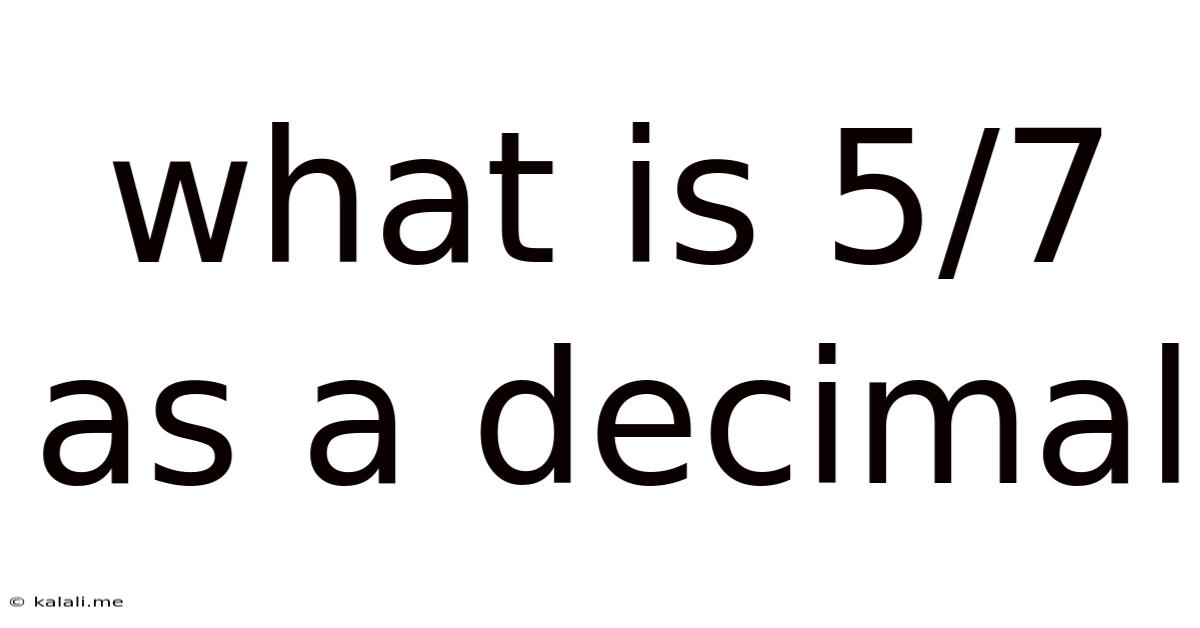What Is 5/7 As A Decimal
Kalali
Apr 19, 2025 · 4 min read

Table of Contents
What is 5/7 as a Decimal? A Deep Dive into Fraction to Decimal Conversion
Converting fractions to decimals is a fundamental concept in mathematics, crucial for various applications across science, engineering, and everyday life. This article will delve into the conversion of the fraction 5/7 to its decimal equivalent, exploring different methods and explaining the underlying principles. We'll also touch upon the broader context of fraction-to-decimal conversion, including recurring decimals and their significance. Understanding this process will not only provide the answer to "What is 5/7 as a decimal?" but also equip you with the knowledge to tackle similar conversions with confidence.
Understanding Fractions and Decimals
Before diving into the specific conversion of 5/7, let's refresh our understanding of fractions and decimals. A fraction represents a part of a whole, expressed as a ratio of two integers: the numerator (top number) and the denominator (bottom number). A decimal, on the other hand, represents a fraction where the denominator is a power of 10 (10, 100, 1000, etc.). The decimal point separates the whole number part from the fractional part.
Method 1: Long Division
The most straightforward method to convert a fraction to a decimal is through long division. To find the decimal representation of 5/7, we divide the numerator (5) by the denominator (7):
0.714285714285...
7 | 5.000000000000
-4.9
0.10
-0.07
0.030
-0.028
0.0020
-0.0014
0.00060
-0.00056
0.000040
-0.000035
0.0000050
-0.0000049
0.0000001...
As you can see, the division process continues indefinitely. This results in a recurring decimal, also known as a repeating decimal. The digits "714285" repeat endlessly. We can represent this recurring decimal using a bar over the repeating sequence: 0.7̅1̅4̅2̅8̅5̅.
Method 2: Using a Calculator
A simpler approach is to use a calculator. Simply enter 5 ÷ 7 and the calculator will display the decimal equivalent. However, due to the limitations of calculator displays, you might only see a truncated version of the recurring decimal, such as 0.7142857. It's important to remember that this is an approximation, not the exact value.
Understanding Recurring Decimals
The result of 5/7 highlights a crucial aspect of decimal representation: not all fractions can be expressed as terminating decimals. Fractions with denominators that have prime factors other than 2 and 5 (like 7 in this case) will result in recurring decimals. This is because the decimal system is based on powers of 10 (2 x 5), and if the denominator contains other prime factors, the division will never terminate.
Significance of Recurring Decimals
Recurring decimals are not simply mathematical curiosities; they have practical applications:
- Scientific Calculations: Many scientific calculations involve fractions that lead to recurring decimals. Understanding these decimals is crucial for accurate results.
- Engineering: Precision in engineering requires working with exact values. While approximations are sometimes necessary, understanding the nature of recurring decimals helps to manage and minimize errors.
- Financial Calculations: Recurring decimals are encountered frequently in financial calculations, such as interest rates and compound interest.
- Computer Programming: Representing and manipulating recurring decimals efficiently is a challenge in computer programming, necessitating specialized algorithms and data structures.
Approximations and Rounding
In practical situations, we often need to use approximations of recurring decimals. Rounding is a common technique to simplify these numbers. For instance, we might round 0.7̅1̅4̅2̅8̅5̅ to:
- 0.71 (rounded to two decimal places)
- 0.714 (rounded to three decimal places)
- 0.7143 (rounded to four decimal places)
The level of precision required will depend on the context. For everyday calculations, rounding to a few decimal places is often sufficient. However, for scientific or engineering applications, a higher level of precision might be needed.
Converting Other Fractions to Decimals
The long division method and calculator method can be applied to convert any fraction to its decimal equivalent. Here are a few examples:
- 1/4 = 0.25 (Terminating decimal)
- 1/3 = 0.3̅ (Recurring decimal)
- 2/5 = 0.4 (Terminating decimal)
- 1/8 = 0.125 (Terminating decimal)
- 1/9 = 0.1̅ (Recurring decimal)
- 1/11 = 0.0̅9̅ (Recurring decimal)
Recognizing Patterns in Recurring Decimals
While the long division method always works, observing patterns in recurring decimals can be insightful. For instance, the fraction 1/7 produces the recurring decimal 0.1̅4̅2̅8̅5̅7̅. Notice how the digits repeat in a specific sequence. Understanding these patterns can help in mental calculations and estimations.
Conclusion: 5/7 as a Decimal and Beyond
To answer the initial question, 5/7 as a decimal is 0.7̅1̅4̅2̅8̅5̅, a recurring decimal. This exploration extended beyond a simple numerical answer, providing a deeper understanding of fraction-to-decimal conversion, the nature of recurring decimals, and their significance across various fields. By mastering this fundamental concept, you'll be better equipped to handle various mathematical challenges and improve your analytical skills. Remember to choose the method – long division or calculator – that best suits your needs and the desired level of accuracy. Understanding the principles behind the conversion, however, is key to appreciating the elegance and power of mathematical operations.
Latest Posts
Latest Posts
-
1 Pint Is How Many Milliliters
Apr 20, 2025
-
16 Over 5 As A Mixed Number
Apr 20, 2025
-
What Is 114 Cm In Inches
Apr 20, 2025
-
4 Meters Equals How Many Feet
Apr 20, 2025
-
How Many 1 3 Are In 1 Cup
Apr 20, 2025
Related Post
Thank you for visiting our website which covers about What Is 5/7 As A Decimal . We hope the information provided has been useful to you. Feel free to contact us if you have any questions or need further assistance. See you next time and don't miss to bookmark.